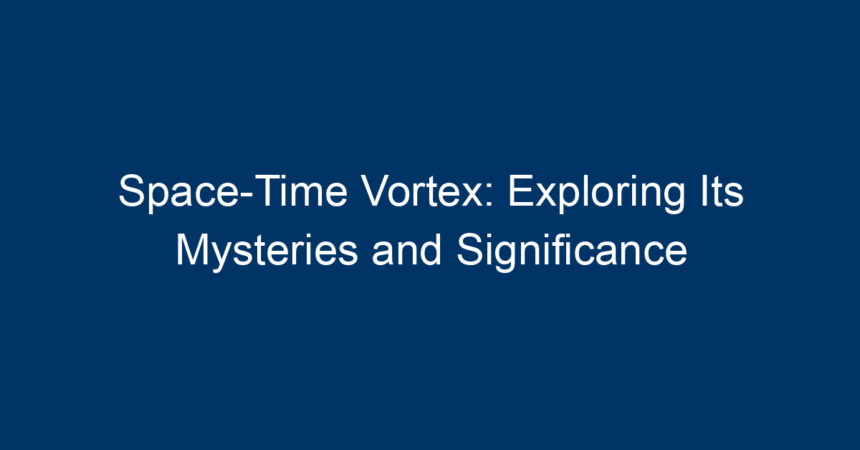The concept of a space-time vortex has captivated the imagination of scientists and science fiction enthusiasts alike. But what exactly is a space-time vortex? How does it relate to our understanding of the universe? In this article, we will delve into the mysteries surrounding space-time vortices, their potential implications, and the significance they hold in modern physics.
Understanding the Basics of Space-Time
Before we can explore the intricacies of a space-time vortex, it’s essential to understand the underlying principles of space-time itself.
What is Space-Time?
Space-time combines the three dimensions of space with the fourth dimension of time into a single four-dimensional continuum. This revolutionary concept, pioneered by Albert Einstein, fundamentally changed our understanding of gravity and motion. According to Einstein’s theory of relativity, objects in the universe do not merely exist within their spatial confines; they also exist within a temporal context.
The Fabric of Space-Time
Visualizing space-time can be challenging. Imagine a two-dimensional sheet, representing space, where various objects are placed. When you introduce time as a third dimension, it adds depth and complexity to that sheet, creating a fabric that can be warped by the mass of celestial bodies like stars and planets. This ‘fabric’ is crucial for our understanding of phenomena such as black holes and gravitational waves.
What is a Space-Time Vortex?
A space-time vortex refers to a hypothetical region within the fabric of space-time where the geometry is distorted significantly. This concept suggests that, under certain extreme conditions, such as near a rotating black hole, space-time can become twisted and turn back on itself.
How Do Space-Time Vortices Work?
The mechanics of a space-time vortex involve complex gravitational interactions. As mass rotates, it generates a gravitational field that can twist the surrounding space-time. This twisting can theoretically allow for shortcuts between two distant points in the universe—a concept popularized in science fiction as "wormholes."
The Theoretical Basis for Space-Time Vortices
The fascinating world of space-time vortices is grounded in various scientific theories and principles, especially those concerning general relativity and quantum mechanics.
General Relativity and Rotating Black Holes
Rotating black holes, also known as Kerr black holes, offer a model for understanding space-time vortices. The intense gravitational pull and rotation cause the surrounding space-time to warp, creating regions where the rules of time and space may behave differently.
Quantum Mechanics and the Nature of Reality
While general relativity describes large-scale phenomena, quantum mechanics unfolds the complexities at atomic and subatomic levels. Researchers are beginning to explore the intersection of these two fields, leading to the possibility that space-time is not as rigid as previously thought. This opens the door to unconventional ideas like vortices in quantum fields.
The Significance of Space-Time Vortices in Science
Potential Applications in Space Travel
One of the most exciting implications of understanding space-time vortices is their potential application in space travel. If it were possible to navigate these twisted regions, it could revolutionize our ability to traverse vast distances in space, making interstellar travel a theoretical reality.
Insights into the Nature of Black Holes
Investigating space-time vortices also gives scientists valuable insight into the nature of black holes. By studying the effects of these vortices, researchers may uncover new properties of black holes that challenge our current understanding, possibly leading to breakthroughs in physics.
Space-Time Vortex in Popular Culture
Literature and Movies
The allure of the space-time vortex extends beyond physics into the realms of literature and cinema. Works such as Interstellar and the Doctor Who series often use these concepts to explore complex narratives involving time travel and parallel universes.
Scientific Discussions
Even outside of fiction, the concept of a space-time vortex is a hot topic in scientific circles. Researchers often discuss its implications for quantum gravity and the quest for a unified theory, drawing interest from physicists, cosmologists, and mathematicians alike.
Current Research and Future Considerations
Ongoing Studies
Scientists are currently engaged in numerous studies to explore the implications of space-time vortices. Advanced simulations and observational data from telescopes may help illuminate how these vortices might operate in the universe.
Ethical Implications
As we edge closer to understanding complex phenomena like space-time vortices, ethical considerations will also arise. With great power comes great responsibility, especially when contemplating the potential for advanced space travel and its implications for humanity.
Actionable Insights: What Can We Learn?
-
Stay Updated: Follow advancements in physics to better understand how theories surrounding space-time vortices evolve.
-
Explore Scientific Literature: Engage with books and research papers on general relativity and quantum mechanics to gain a foundational grasp of the concepts involved.
-
Encourage Interdisciplinary Studies: Promote discussions that connect theoretical physics with philosophy, ethics, and even art, as these fields can provide new perspectives on complex scientific ideas.
- Participate in Public Discussions: Engage in forums or community discussions focused on theories of the universe, sharing insights and asking questions about space-time vortices and beyond.
Conclusion
The exploration of the space-time vortex is not just a scientific endeavor; it is a journey into the boundaries of human knowledge and understanding. By unraveling its mysteries, we not only expand the frontiers of physics but also our capacity to dream of what lies beyond. As research progresses, so too will our grasp of the universe’s fundamental mechanics, allowing us to better appreciate our place within it. Whether through the lens of science or popular culture, the concept of space-time vortices continues to inspire, provoking curiosity and wonder about the cosmos.




